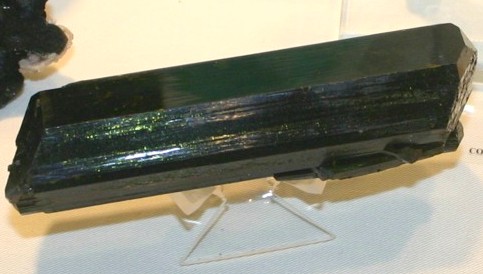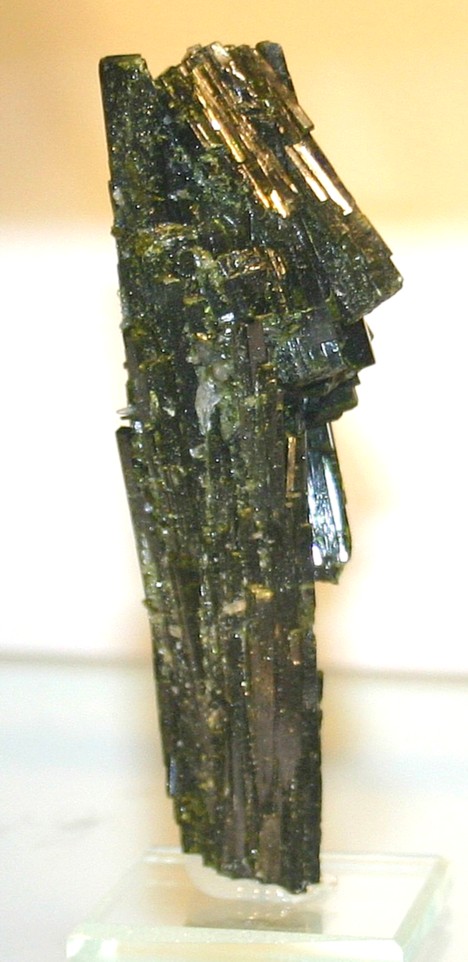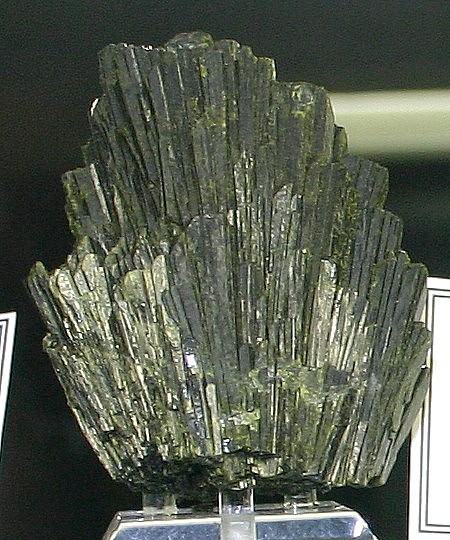|
.
Epidote Mineral Facts:
Chemical Formula: Ca2(Al-Fe)3(OH)(SiO4)3
Silicate of aluminum, calcium and iron, with water. Epidote differs from
the monoclinic dimorph of zoisite (clinozoisite) in that it contains an
admixture of the corresponding iron silicate which is unknown as an
independent mineral. Since it consists of a mixture of an aluminum and
an iron compound its exact composition necessarily varies by location.
Colors:
Typically some
shade of green, including pistachio green, blackish green, and a dark
oil green. Occasionally brown
or rarely even red.
Streak is gray.
Hardness:
6.5
Density:
3.3 to 3.5
Cleavage:
Perfect basal cleavage
Its cleavage is very perfect parallel to (00I).
Crystallography: Monoclinic
Crystals are often much elongated parallel to the ortho-axis with a
prominent development of the faces of the orthodome zone, giving them a
prismatic aspect.
Striated parallel to the
ortho-axis. Terminated usually only at one end of the ortho-axis and
most commonly by the two faces of a pyramid. Twinning shown at times.
Luster:.
Vitreous
luster.
Transparent to translucent and strongly pleochroic, appearing dark green in
one direction, and brown in a direction at right angles to the first.
Optics:
(Refractive Index): a= 1.7238; b= 1.7291; y= 1.7343
|
 |
|
Composition,
Structure and Associated Minerals:
The name "epidote" is derived from the Greek, epidosis, increase, the
base of the prism having one side longer than the other. In chemical
composition they are silicates of aluminium, iron, calcium,
and hydrogen, with minor amounts of manganese, magnesium, cerium, etc.
Identification and Diagnostics
Fragments
of the mineral when heated before the blowpipe yield
water and fuse to a dark brown or black mass that is often magnetic.
With increase in iron fusion becomes more easy. Before fusion epidote is
practically insoluble in acid. After heating HC1 decomposes it with the
separation of gelatinous silica. Fuses to a black slag and on intense
ignition in a closed tube it yields a little water. It gives a positive
reaction for iron.
The ordinary forms of the mineral are characterized by their yellowish green
color, ready fusibility and crystallization.
Occurrence,
Localities and Origins:
Epidote is often
found in very fine crystals, making it desirable for mineral collectors.
Many different crystal derivations of its monoclinic form.
Epidote
occurs commonly in the crystalline metamorphic rocks; including gneiss,
amphibolite and various schists. It is formed frequently also during the
metamorphism of an impure
limestone. It also forms massive veins cutting crystalline
schists and igneous rocks, as isolated crystals and druses on the
walls of fissures through almost any rock and in any cavities that may be in
them, and as the principal constituent of the rock known as epidosite.
It is a common alteration product of the feldspars, pyroxenes, garnet, and
other calcium and iron-bearing minerals. Pseudomorphs of epidote after these
minerals are well known. The mineral is a weathering product, but is more
commonly found as a product of contact and regional metamorphism.
Epidote
crystals are so widely spread that only a few of
the important localities in which they have been found in fine crystal forms
are mentioned here. Particularly fine crystals occur in the Sulzbachthal,
Salzburg, Austria; in the Zillerthal, in Tyrol; near Zermatt, in
Switzerland; in the Alathal, Traversella, Italy; Bourg d'Oisans, Dauphine,
France; at Arendal, Norway; in Japan, at Prince of Wales Island, Alaska,
Haddam, Connecticut; Riverside, California and at many other points in North
America.
Return to the
Mineral Collectors Information Page |
 |
|




